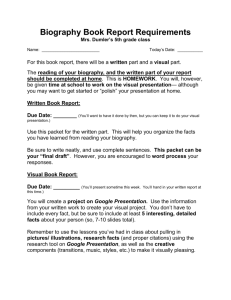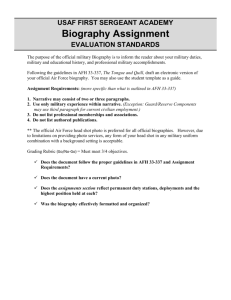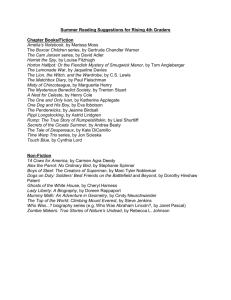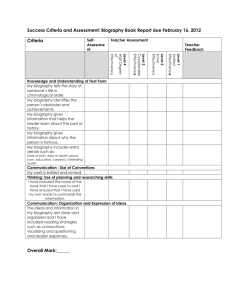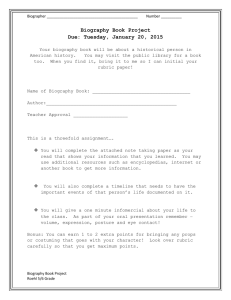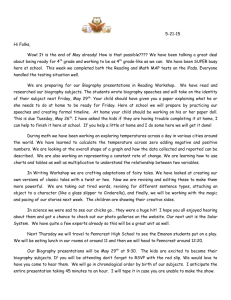File
advertisement
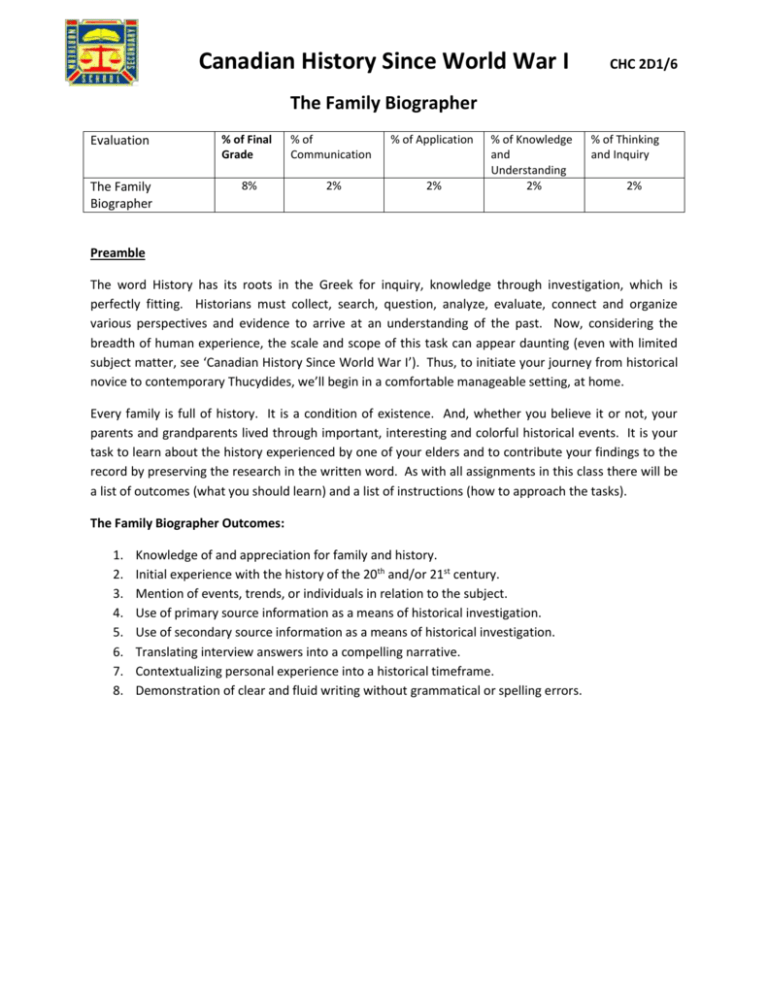
Canadian History Since World War I CHC 2D1/6 The Family Biographer Evaluation % of Final Grade % of Communication % of Application The Family Biographer 8% 2% 2% % of Knowledge and Understanding 2% % of Thinking and Inquiry 2% Preamble The word History has its roots in the Greek for inquiry, knowledge through investigation, which is perfectly fitting. Historians must collect, search, question, analyze, evaluate, connect and organize various perspectives and evidence to arrive at an understanding of the past. Now, considering the breadth of human experience, the scale and scope of this task can appear daunting (even with limited subject matter, see ‘Canadian History Since World War I’). Thus, to initiate your journey from historical novice to contemporary Thucydides, we’ll begin in a comfortable manageable setting, at home. Every family is full of history. It is a condition of existence. And, whether you believe it or not, your parents and grandparents lived through important, interesting and colorful historical events. It is your task to learn about the history experienced by one of your elders and to contribute your findings to the record by preserving the research in the written word. As with all assignments in this class there will be a list of outcomes (what you should learn) and a list of instructions (how to approach the tasks). The Family Biographer Outcomes: 1. 2. 3. 4. 5. 6. 7. 8. Knowledge of and appreciation for family and history. Initial experience with the history of the 20th and/or 21st century. Mention of events, trends, or individuals in relation to the subject. Use of primary source information as a means of historical investigation. Use of secondary source information as a means of historical investigation. Translating interview answers into a compelling narrative. Contextualizing personal experience into a historical timeframe. Demonstration of clear and fluid writing without grammatical or spelling errors. Canadian History Since World War I CHC 2D1/6 The Family Biographer The Family Biographer involves conducting an interview, reviewing the answers and forming a short narrative. As with all assignments, follow the specific instructions and look at the rubric to view how marks are derived. The Family Biographer Instructions: 1. Select a family member or members to interview and ask their permission (if there are no family members available choose a family friend or neighbor). 2. Set up a prearranged date and time, and abide by this, but be flexible if they need to change. 3. If possible select a person with more life experience (age usually helps but not always). 4. Create 10 to 20 interview questions (a good interview in this case may deviate from your script and become more of a conversation or discussion – that’s okay). You may need to do some prior research to ask good critical questions. 5. The interview questions should ask the basics (origins, birth, marriage, children, among others) and extend to moments of interest and historical context. 6. Ask follow up questions when the story gets interesting. 7. Remember to explore how key social, economic, and political events in Canadian/World history have shaped your family history. Conduct research so you are aware of the historical context and to compare official accounts of history to that of your subject. 8. Attempt to capture some amount of historical significance and perspective (how is this story important and unique). 9. If your subject was not a participant in major historical events, adjust and look at more local or personal events, ask how the events of the time impacted the subject. 10. Post interview(s) organize and sequence your interview notes then consider the structure of your written work (a narrative seems natural but may not work in the space allotted so maybe an essay works better, or, you just capture a particular time in the life of the subject – be creative here). 11. Plan a beginning, middle and end, so to speak, but this may not exactly work. 12. Begin to compose your biography by starting a few days ahead of time, not the night before. 13. Type please. 14. The final product should be 2 pages, not too much more (seriously – I will stop reading after 2 and ½) and not too much less (1 is unacceptable). 15. Title the biography, place your name on the first page in the left hand corner and use standard font and spacing. (nothing larger than 12 point font) 16. When complete use spell and grammar check then have a parent or peer edit. 17. Submit punctually. Canadian History Since World War I CHC 2D1/6 The Family Biographer Rubric Below Level 1 0 – 49% Level 1 50 – 59% Biography inadequately communicated with many grammatical or spelling errors. Biography almost adequately communicated with many grammatical or spelling errors. 10 11 0 2 4 6 8 Below Level 1 0 – 49% Level 1 50 – 59% There was no research and an absence of historical context. Research was minimally employed to show some historical context. 0 2 4 6 Below Level 1 0 – 49% 8 10 11 Level 2 Level 3 60 – 69% 70 – 79% Communication Biography Biography effectively adequately communicated with communicated with minimal grammatical some grammatical or spelling errors. or spelling errors. 12 13 14 15 16 Level 4 80 – 100% Level 2 60 – 69% Application Research was employed to somewhat illustrate historical context within a narrative. 12 13 Level 3 70 – 79% Level 4 80 – 100% Research was well employed to illustrate historical context within a narrative. Thorough research was adeptly employed to illustrate historical context within a flowing narrative. 14 15 Biography very effectively communicated without grammatical or spelling errors. 17 16 Level 1 50 – 59% 17 Level 2 Level 3 60 – 69% 70 – 79% Knowledge and Understanding Almost no understanding of and A partial understanding An adequate A good understanding of respect for the subject was of and respect for the understanding of and respect for the evident as specific experiences subject was evident and respect for the subject was evident with and events were not recounted. with specific subject was evident specific experiences and experiences and events with specific events recounted. barely recounted. experiences and events recounted. 0 2 4 6 8 10 11 12 13 14 15 16 Level 4 80 – 100% Below Level 1 0 – 49% Level 4 80 – 100% Level 1 50 – 59% Inadequate structure and sequencing resulted in an uninteresting biography; historical significance and perspective was not captured. 0 2 4 6 Almost adequate structure and sequencing resulted in a biography with minimal interesting material; historical significance and perspective was barely captured. 8 10 11 Level 2 60 – 69% Thinking and Inquiry Adequate structure and sequencing resulted in a biography that had some interesting material; historical significance and perspective was partially captured. 12 13 14 Level 3 70 – 79% Sound structure and logical sequencing resulted in a captivating biography; historical significance and perspective was mostly captured. 15 16 18 18 19 19 20 20 A thorough understanding of and respect for the subject was evident with specific experiences and events vividly recounted. 17 18 19 20 Thoughtful structure and very logical sequencing resulted in a very captivating biography; historical significance and perspective was captured. 17 18 19 _____________________________________________________________________________________ _____________________________________________________________________________________ _____________________________________________________________________________________ /80 20

